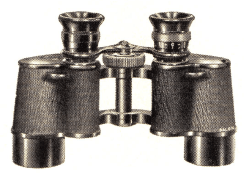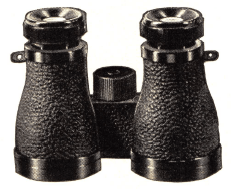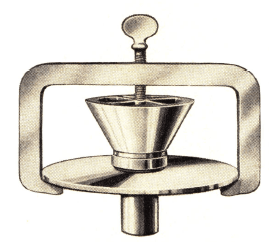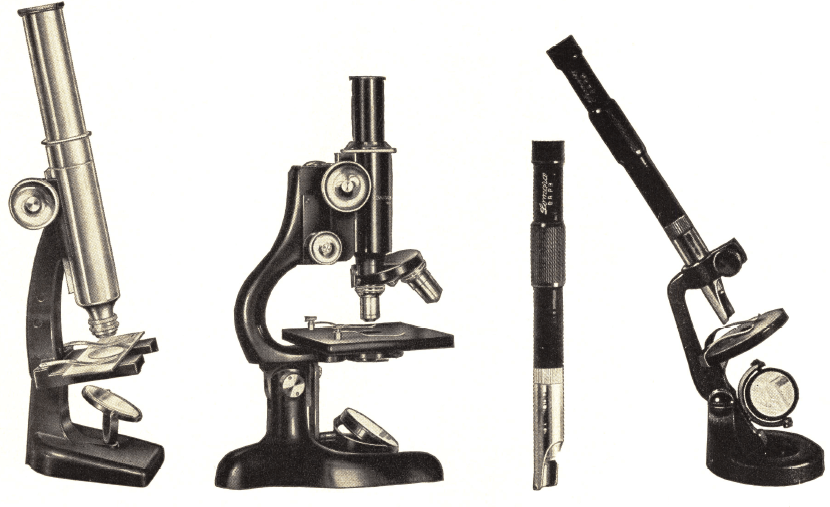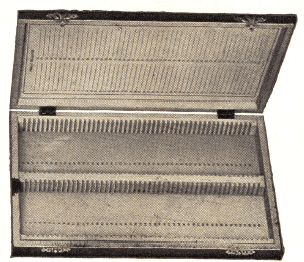MAGNIFIER, Coddington—First quality. Mounted in nickeled folding case.
MAGNIFIER, Doublet—Composed of two piano convex lenses, set in nickeled folding case.
MAGNIFIER—In nickeled metal folding case. Diameter of lens, 1¼ inches.
MAGNIFIER, Reading Lens—Clear white optical glass lens, accurately ground and highly polished, mounted in nickel rim of sufficient width to protect the lens surface, with handles of ebonized wood.
MAGNIFIER, Folding—Brass frame. Folds to ¼x¾x1 inch. Diameter of lens, 3/8 inch.
MAGNIFIER, Tripod—Focused by screwing up or down. Magnification, 7.5 diameters.
MAGNIFIER, Pocket Magnarule—Sides graduated in inches and millimeters. Fitted with lens 1¼ inch diameter of clear white optical glass; magnification, approximately 3½X. Made of polished crystal zylonite.
FIELD GLASS, Stereo-Prism Binocular, Bausch & Lomb—A 6X, 25 mm. diameter aperture, compact, light-weight glass, well adapted to the study of birds and animals because of its good illumination. This glass gives an angular field of 8° 36′, or a lineal field 150 yards wide at a distance of 1,000 yards. Complete in case with neck and shoulder straps.
FIELD GLASS, Bausch & Lomb—A 4X, compact, light-weight glass that can be carried conveniently in the coat pocket. Eliminates three-quarters of the distance of objects seen through it. Very good for bird study. Large objective lenses furnish high light transmission. Complete in case with shoulder straps.
MATCHES, Safety—In cartons of 12 boxes.
MERCURY DETERMINATION APPARATUS, Whitton—For the determination of mercury in ores. Consists of a steel retort with a cover of sheet silver, and above these a flat-bottomed cooling dish of brass, all clamped tightly together. The distillation is thus performed in a closed retort, preventing the escape of mercury vapor, and rendering careful regulation of the heat unnecessary. The time required for an assay is about 30 minutes. Completes with one foil and directions, but without burner.
Extra Silver foil.
Iron Filings—Specially prepared, free from grease, for use with above.
MICROSCOPE, New Gem, B. & L.—A small, well made microscope, with magnification range from 75 to 300X. With draw tube and double objective lens, and rack and pinion adjustment for focusing. The detachable base is a useful feature. To examine a rock or a piece of quartz that is too large for the stage of the microscope, the base is easily pulled off so that the instrument may be placed directly on the object to be examined. With the base detached, the mirror is placed on the pillar of the instrument to reflect light down onto the object. Finished in black lacquer and chromium plate.
MICROSCOPE, Bausch & Lomb, Model FS2—For general laboratory work with 160 mm. fixed length body tube, side fine adjustment with graduated head for measurement of vertical movement, standard objectives and eyepieces, double revolving nosepiece, 102 mm. square stage and inclination joint. With iris diaphragm beneath the stage to regulate the illumination. The objectives are centered and so nearly parfocalized only a slight movement of the fine adjustment is required when turning from one to the other. Supplied with one 16 mm. and one 4 mm. dry achromatic objectives and a 10X Huygenian eyepiece giving magnifications of 100X and 430X. Finished in reagent and alcohol proof black, with exposed metal chromium plated. Complete in hardwood case with lock and key.
MICROSCOPE, Lomara Pocket—A compact and convenient little microscope of substantial magnifying power which may be carried in the pocket like a fountain pen. Suitable for various work within the limits of its magnifying powers. Nicely finished in black ebony, has full achromatic lenses, a clearly defined field, and a smoothly working precision focusing movement. Supplied with two achromatic objectives and an achromatic eyepiece, giving a magnification range of from 15 to 50X. Complete in brown leather case.
STAND, Microscope, Lomara—A neat and compact stand with stage with spring fingers for holding slides, rotating diaphragm and double mirror reflector (plane and concave), for use with the Lomara Pocket Microscope. A clamp and thumb screw arrangement holds the microscope securely, and the stand may be inclined to any convenient position for easy observation.
OBJECTIVE SET, Microscope, Lomara—For use with the Lomara Pocket Microscope when higher magnifications are desired. Gives selective magnifications of from 80 to 250X.
MICROSCOPE, Ultra-Lomara—A pocket microscope of larger size with a larger field and other improvements over the No. 37871. Supplied complete with reflector for illuminating the specimen and optical equipment giving a magnification range of from 20 to 195X. In velvet lined case.
MICROSCOPE, Lomara Clip—A simplified model of the Lomara Pocket Microscope wherein the precision focusing screw of the standard Lomara is replaced by a smooth sliding adjustment, and the instrument is provided with a clip for attaching to the pocket. Supplied with two achromatic objectives and an achromatic eyepiece, giving a magnification range of from 15 to 50X.
CASE, Leather carrying—For the No. 37874 Lomara Clip Microscope.
MICRO SLIDE, Non-Corrosive, “Diamond”—Standard size 75×25 mm. (3×1 inches). Medium thickness (about 1 mm.). Made of hard crown glass, showing a slight greenish tint when viewed in thick layers. These slides are the best obtainable quality for microscopic work and are guaranteed against corrosion. Packed in ½ gross cartons.
MICRO COVER GLASS, Square, Non-Corrosive, “Diamond”—Made of hard crown glass. These cover glasses are the best obtainable quality for microscopic work and are guaranteed against corrosion. Packed in ½ ounce cartons.
MICRO COVER GLASS, Circular, Non-Corrosive, “Diamond”—Of the same glass as Nos. 38310 and 38311 and guaranteed against corrosion. Packed in ½ ounce cartons.
MICRO SLIDE LABEL, Gummed, Square—Of best white paper with black border. Size, 22 mm. square.
MICRO SLIDE BOX—Capacity 100 slides, 3×1 inches. Of wood with hinged cover, two clasps, and index.




